Physical Address
304 North Cardinal St.
Dorchester Center, MA 02124
Genes, which are located in the nuclei of all cells of the body, control heredity from parents to children, as well as the daily functioning of all the body’s cells. The genes control cell function by determining which structures, enzymes, and chemicals are synthesized within the cell.
Figure 3-1 shows the general schema of genetic control. Each gene, which is composed of deoxyribonucleic acid (DNA), controls the formation of another nucleic acid, ribonucleic acid (RNA); this RNA then spreads throughout the cell to control formation of a specific protein. The entire process, from transcription of the genetic code in the nucleus to translation of the RNA code and the formation of proteins in the cell cytoplasm, is often referred to as gene expression.
Because the human body has approximately 20,000 to 25,000 different genes that code for proteins in each cell, it is possible to form a large number of different cellular proteins. In fact, RNA molecules transcribed from the same segment of DNA—the same gene—can be processed in more than one way by the cell, giving rise to alternate versions of the protein. The total number of different proteins produced by the various cell types in humans is estimated to be at least 100,000.
Some of the cellular proteins are structural proteins, which, in association with various lipids and carbohydrates, form structures of the various intracellular organelles discussed in Chapter 2 . However, most of the proteins are enzymes that catalyze different chemical reactions in the cells. For example, enzymes promote all the oxidative reactions that supply energy to the cell, along with synthesis of all the cell chemicals, such as lipids, glycogen, and adenosine triphosphate (ATP).
In the cell nucleus, large numbers of genes are attached end on end in extremely long, double-stranded helical molecules of DNA having molecular weights measured in the billions. A very short segment of such a molecule is shown in Figure 3-2 . This molecule is composed of several simple chemical compounds bound together in a regular pattern, the details of which are explained in the next few paragraphs.
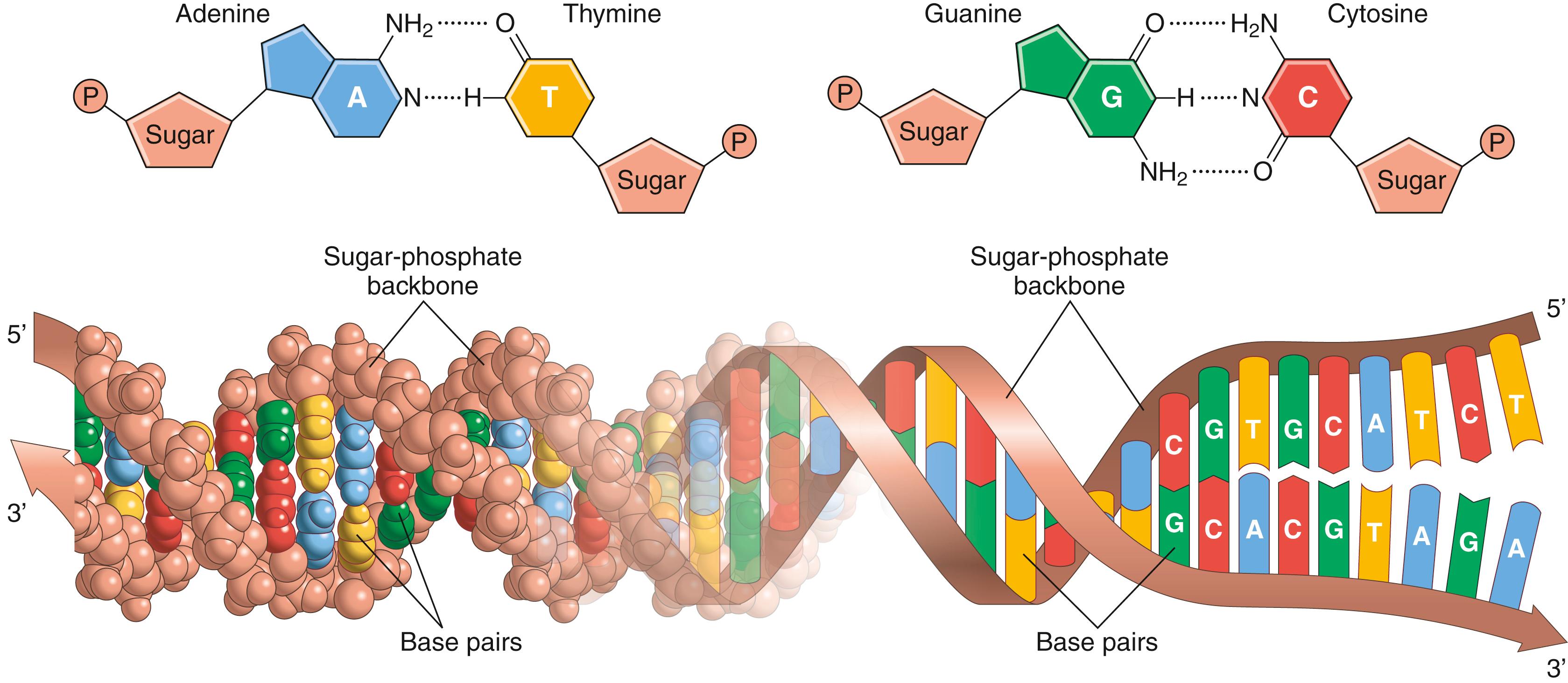
Figure 3-3 shows the basic chemical compounds involved in the formation of DNA. These compounds include the following: (1) phosphoric acid; (2) a sugar called deoxyribose; and (3) four nitrogenous bases (two purines, adenine and guanine, and two pyrimidines, thymine and cytosine ). The phosphoric acid and deoxyribose form the two helical strands that are the backbone of the DNA molecule, and the nitrogenous bases lie between the two strands and connect them, as illustrated in Figure 3-2 .
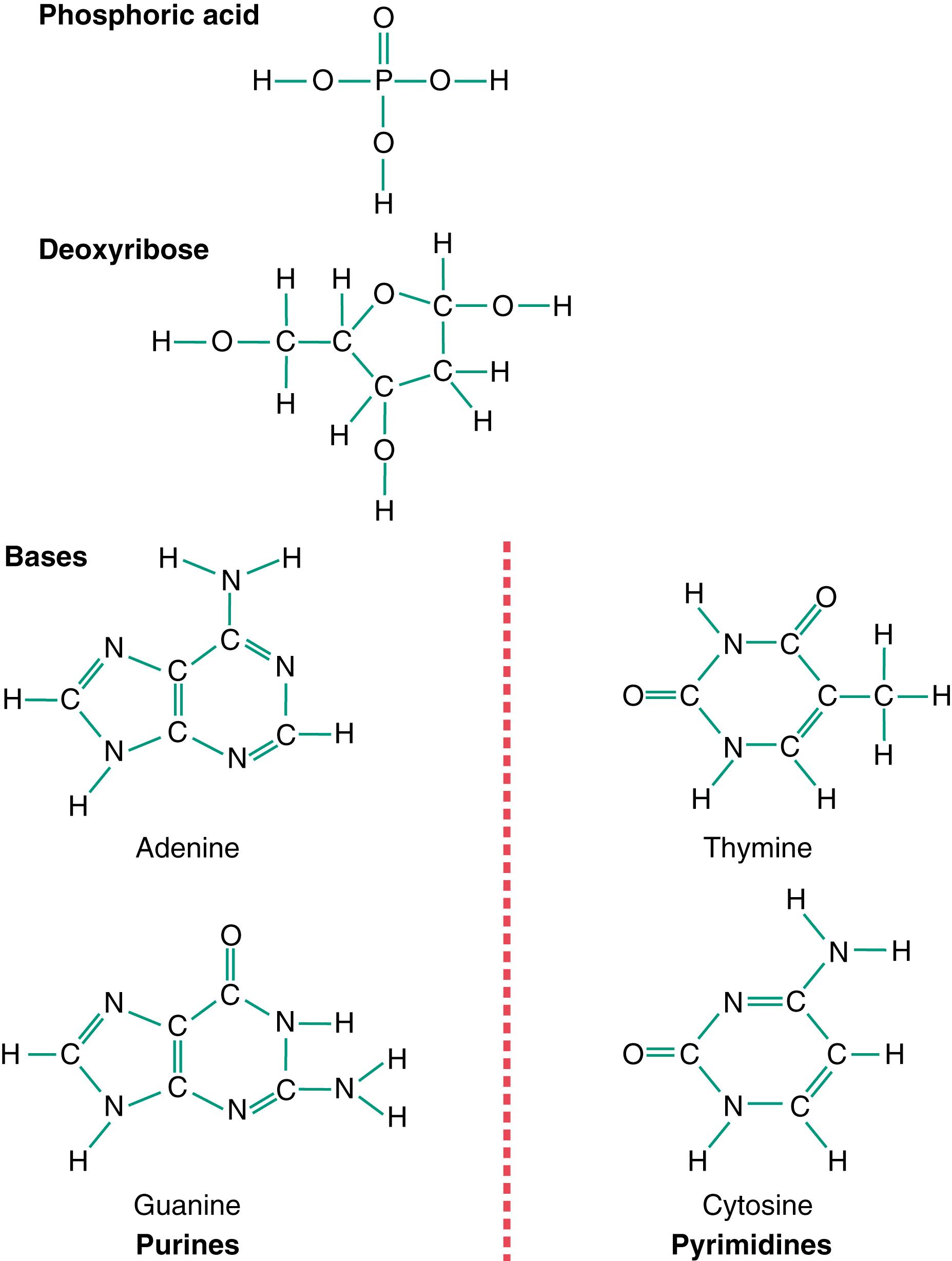
The first stage of DNA formation is to combine one molecule of phosphoric acid, one molecule of deoxyribose, and one of the four bases to form an acidic nucleotide. Four separate nucleotides are thus formed, one for each of the four bases: deoxyadenylic, deoxythymidylic, deoxyguanylic, and deoxycytidylic acids . Figure 3-4 shows the chemical structure of deoxyadenylic acid, and Figure 3-5 shows simple symbols for the four nucleotides that form DNA.
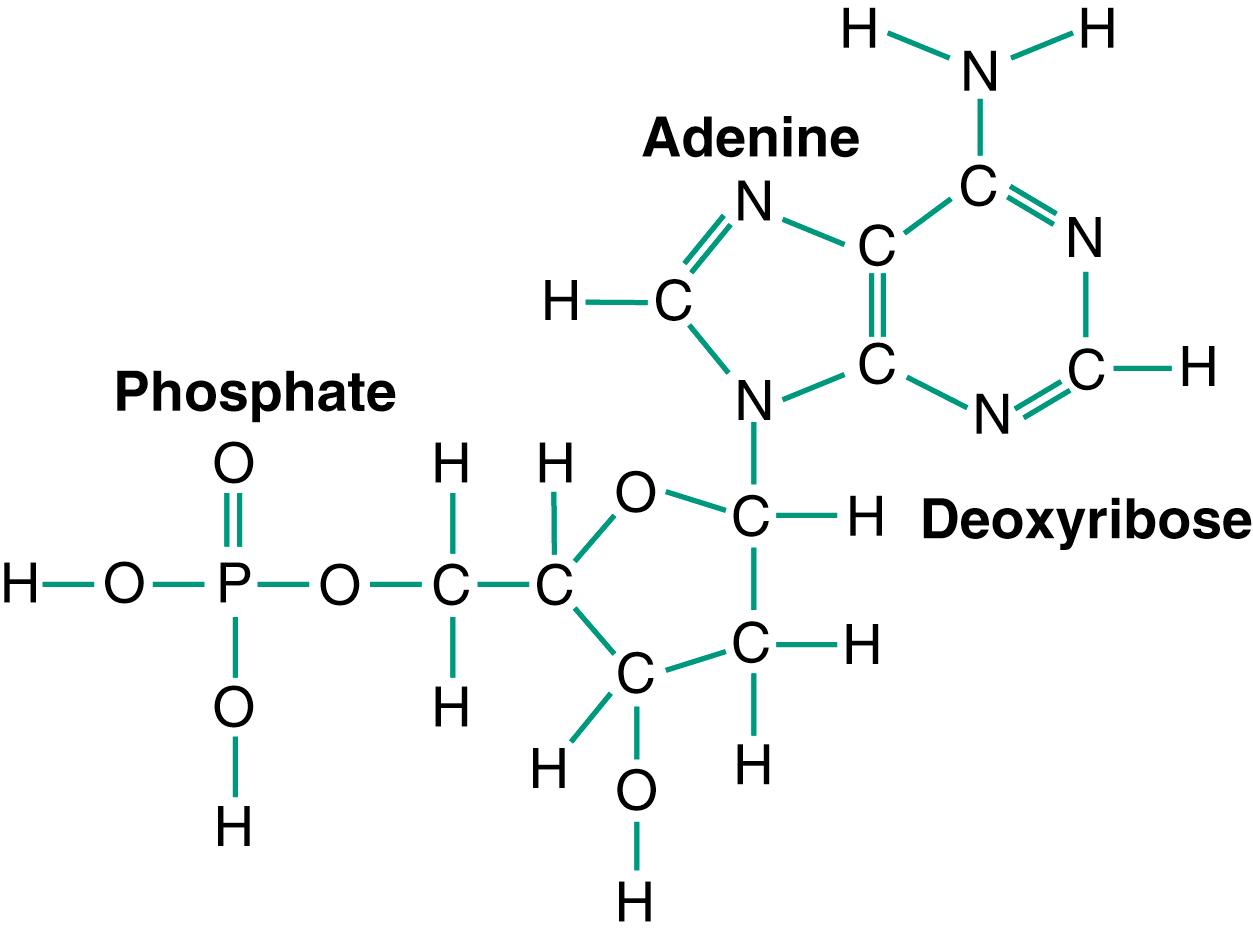
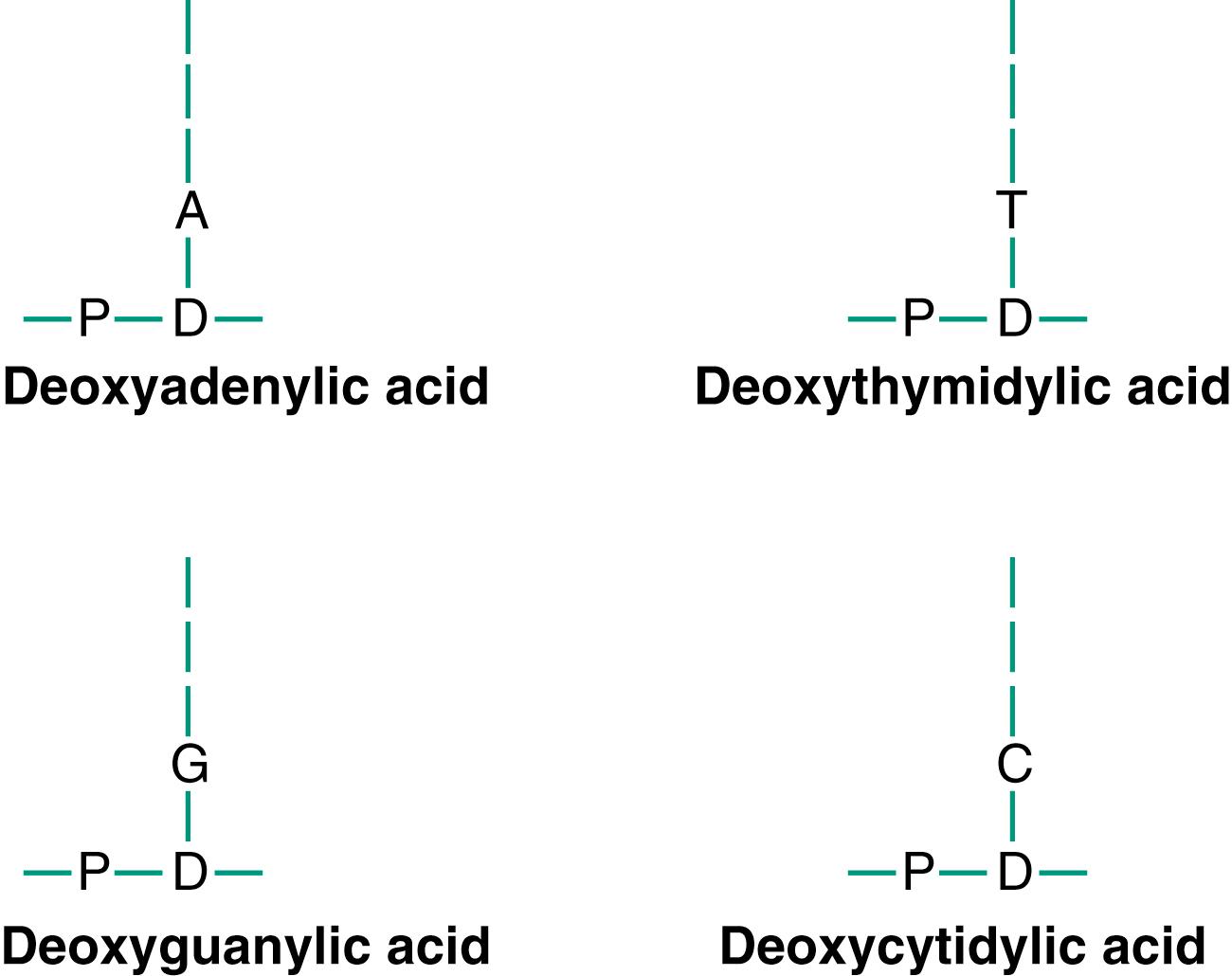
Figure 3-2 shows the manner in which multiple nucleotides are bound together to form two strands of DNA. The two strands are, in turn, loosely bonded with each other by weak cross-linkages, as illustrated in Figure 3-6 by the central dashed lines. Note that the backbone of each DNA strand is composed of alternating phosphoric acid and deoxyribose molecules. In turn, purine and pyrimidine bases are attached to the sides of the deoxyribose molecules. Then, by means of loose hydrogen bonds (dashed lines) between the purine and pyrimidine bases, the two respective DNA strands are held together. Note the following caveats, however:
Each purine base adenine of one strand always bonds with a pyrimidine base thymine of the other strand.
Each purine base guanine always bonds with a pyrimidine base cytosine.
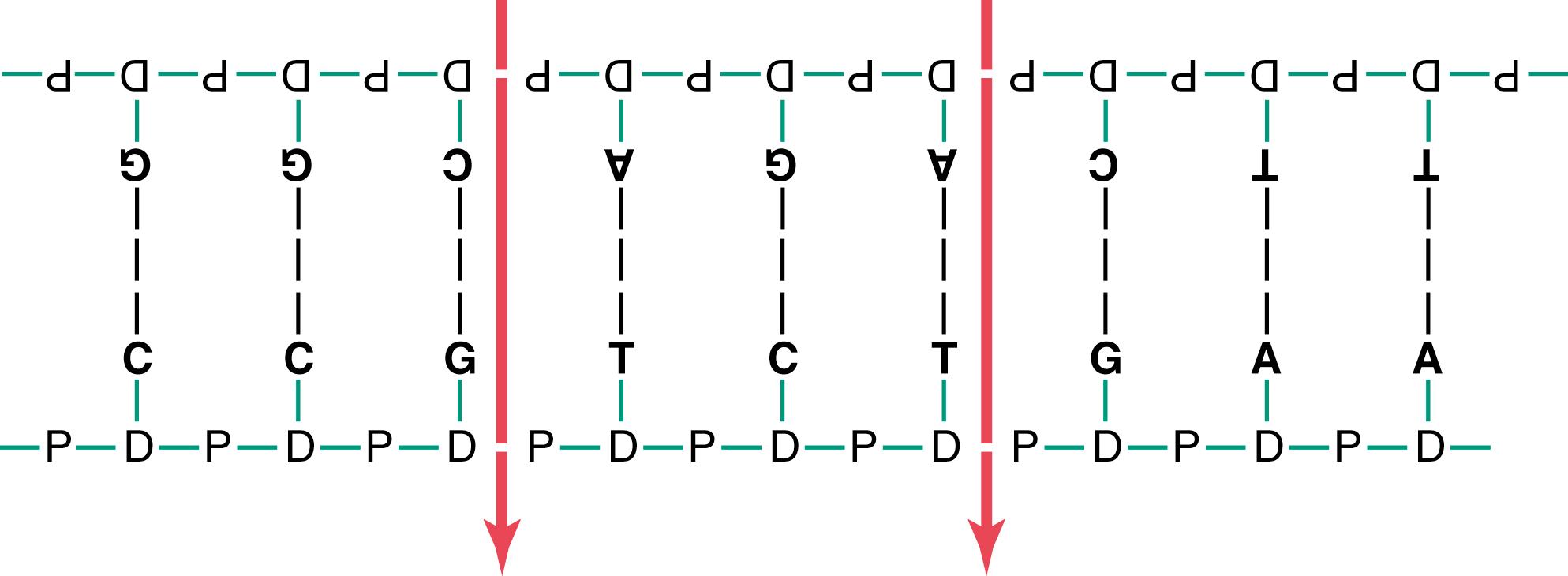
Thus, in Figure 3-6 , the sequence of complementary pairs of bases is CG, CG, GC, TA, CG, TA, GC, AT, and AT. Because of the looseness of the hydrogen bonds, the two strands can pull apart with ease, and they do so many times during the course of their function in the cell.
To put the DNA of Figure 3-6 into its proper physical perspective, one could merely pick up the two ends and twist them into a helix. Ten pairs of nucleotides are present in each full turn of the helix in the DNA molecule.
The importance of DNA lies in its ability to control the formation of proteins in the cell, which it achieves by means of a genetic code. That is, when the two strands of a DNA molecule are split apart, the purine and pyrimidine bases projecting to the side of each DNA strand are exposed, as shown by the top strand in Figure 3-7 . It is these projecting bases that form the genetic code.
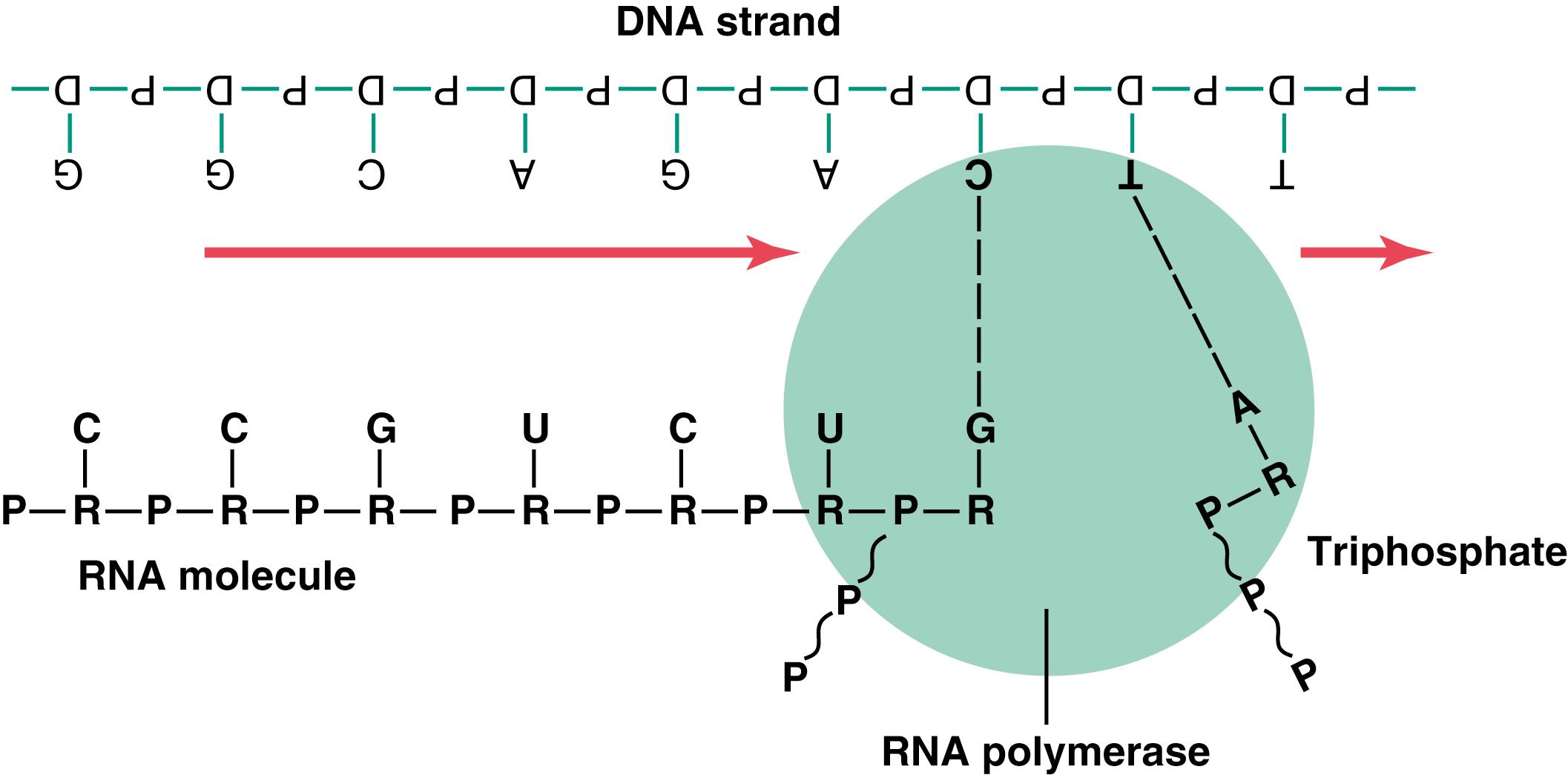
The genetic code consists of successive “triplets” of bases—that is, each three successive bases is a code word. The successive triplets eventually control the sequence of amino acids in a protein molecule that is to be synthesized in the cell. Note in Figure 3-6 that the top strand of DNA, reading from left to right, has the genetic code GGC, AGA, CTT, with the triplets being separated from one another by the arrows. As we follow this genetic code through Figure 3-7 and Figure 3-8 , we see that these three respective triplets are responsible for successive placement of the three amino acids, proline, serine, and glutamic acid, in a newly formed molecule of protein.

Because DNA is located in the cell nucleus, yet most of the cell functions are carried out in the cytoplasm, there must be some means for DNA genes of the nucleus to control chemical reactions of the cytoplasm. This control is achieved through the intermediary of another type of nucleic acid, RNA, the formation of which is controlled by DNA of the nucleus. Thus, as shown in Figure 3-7 , the code is transferred to RNA in a process called transcription. The RNA, in turn, diffuses from the nucleus through nuclear pores into the cytoplasmic compartment, where it controls protein synthesis.
During RNA synthesis, the two strands of DNA separate temporarily; one of these strands is used as a template for synthesis of an RNA molecule. The code triplets in the DNA result in the formation of complementary code triplets (called codons ) in the RNA. These codons, in turn, will control the sequence of amino acids in a protein to be synthesized in the cell cytoplasm.
The basic building blocks of RNA are almost the same as those of DNA, except for two differences. First, the sugar deoxyribose is not used in RNA formation. In its place is another sugar of slightly different composition, ribose, which contains an extra hydroxyl ion appended to the ribose ring structure. Second, thymine is replaced by another pyrimidine, uracil.
The basic building blocks of RNA form RNA nucleotides, exactly as described previously for DNA synthesis. Here again, four separate nucleotides are used to form RNA. These nucleotides contain the bases adenine, guanine, cytosine, and uracil. Note that these bases are the same as in DNA, except that uracil in RNA replaces thymine in DNA.
The next step in the synthesis of RNA is “activation” of RNA nucleotides by an enzyme, RNA polymerase. This activation occurs by adding two extra phosphate radicals to each nucleotide to form triphosphates (shown in Figure 3-7 by the two RNA nucleotides to the far right during RNA chain formation). These last two phosphates are combined with the nucleotide by high-energy phosphate bonds derived from ATP in the cell.
The result of this activation process is that large quantities of ATP energy are made available to each of the nucleotides. This energy is used to promote chemical reactions that add each new RNA nucleotide at the end of the developing RNA chain.
As shown in Figure 3-7 , assembly of RNA is accomplished under the influence of an enzyme, RNA polymerase. This large protein enzyme has many functional properties necessary for formation of RNA, as follows:
In the DNA strand immediately ahead of the gene to be transcribed is a sequence of nucleotides called the promoter. The RNA polymerase has an appropriate complementary structure that recognizes this promoter and becomes attached to it, which is the essential step for initiating the formation of RNA.
After the RNA polymerase attaches to the promoter, the polymerase causes unwinding of about two turns of the DNA helix and separation of the unwound portions of the two strands.
The polymerase then moves along the DNA strand, temporarily unwinding and separating the two DNA strands at each stage of its movement. As it moves along, at each stage it adds a new activated RNA nucleotide to the end of the newly forming RNA chain through the following steps:
First, it causes a hydrogen bond to form between the end base of the DNA strand and the base of an RNA nucleotide in the nucleoplasm.
Then, one at a time, the RNA polymerase breaks two of the three phosphate radicals away from each of these RNA nucleotides, liberating large amounts of energy from the broken high-energy phosphate bonds. This energy is used to cause covalent linkage of the remaining phosphate on the nucleotide with the ribose on the end of the growing RNA chain.
When the RNA polymerase reaches the end of the DNA gene, it encounters a new sequence of DNA nucleotides called the chain-terminating sequence, which causes the polymerase and the newly formed RNA chain to break away from the DNA strand. The polymerase then can be used again and again to form more new RNA chains.
As the new RNA strand is formed, its weak hydrogen bonds with the DNA template break away because the DNA has a high affinity for rebonding with its own complementary DNA strand. Thus, the RNA chain is forced away from the DNA and is released into the nucleoplasm.
Therefore, the code that is present in the DNA strand is eventually transmitted in complementary form to the RNA chain. The ribose nucleotide bases always combine with the deoxyribose bases in the following combinations:
|
|
|---|---|
|
|
|
|
|
|
|
|
As research on RNA has continued to advance, many different types of RNA have been discovered. Some types of RNA are involved in protein synthesis, whereas other types serve gene regulatory functions or are involved in posttranscriptional modification of RNA. The functions of some types of RNA, especially those that do not appear to code for proteins, are still mysterious. The following six types of RNA play independent and different roles in protein synthesis:
Precursor messenger RNA (pre-mRNA) is a large, immature, single strand of RNA that is processed in the nucleus to form mature messenger RNA (mRNA). The pre-RNA includes two different types of segments, called introns, which are removed by a process called splicing, and exons, which are retained in the final mRNA.
Small nuclear RNA (snRNA) directs the splicing of pre-mRNA to form mRNA.
Messenger RNA (mRNA) carries the genetic code to the cytoplasm for controlling the type of protein formed.
Transfer RNA (tRNA) transports activated amino acids to the ribosomes to be used in assembling the protein molecule.
Ribosomal RNA, along with about 75 different proteins, forms ribosomes, the physical and chemical structures on which protein molecules are actually assembled.
MicroRNAs (miRNAs) are single-stranded RNA molecules of 21 to 23 nucleotides that can regulate gene transcription and translation.
Messenger RNA molecules are long single RNA strands that are suspended in the cytoplasm. These molecules are composed of several hundred to several thousand RNA nucleotides in unpaired strands, and they contain codons that are exactly complementary to the code triplets of the DNA genes. Figure 3-8 shows a small segment of mRNA. Its codons are CCG, UCU, and GAA, which are the codons for the amino acids proline, serine, and glutamic acid. The transcription of these codons from the DNA molecule to the RNA molecule is shown in Figure 3-7 .
Table 3-1 lists the RNA codons for the 20 common amino acids found in protein molecules. Note that most of the amino acids are represented by more than one codon; also, one codon represents the signal “start manufacturing the protein molecule,” and three codons represent “stop manufacturing the protein molecule.” In Table 3-1 , these two types of codons are designated CI for “chain-initiating” or “start” codon and CT for “chain-terminating” or “stop” codon.
| Amino Acid | RNA Codons | |||||
|---|---|---|---|---|---|---|
| Alanine | GCU | GCC | GCA | GCG | ||
| Arginine | CGU | CGC | CGA | CGG | AGA | AGG |
| Asparagine | AAU | AAC | ||||
| Aspartic acid | GAU | GAC | ||||
| Cysteine | UGU | UGC | ||||
| Glutamic acid | GAA | GAG | ||||
| Glutamine | CAA | CAG | ||||
| Glycine | GGU | GGC | GGA | GGG | ||
| Histidine | CAU | CAC | ||||
| Isoleucine | AUU | AUC | AUA | |||
| Leucine | CUU | CUC | CUA | CUG | UUA | UUG |
| Lysine | AAA | AAG | ||||
| Methionine | AUG | |||||
| Phenylalanine | UUU | UUC | ||||
| Proline | CCU | CCC | CCA | CCG | ||
| Serine | UCU | UCC | UCA | UCG | AGC | AGU |
| Threonine | ACU | ACC | ACA | ACG | ||
| Tryptophan | UGG | |||||
| Tyrosine | UAU | UAC | ||||
| Valine | GUU | GUC | GUA | GUG | ||
| Start (CI) | AUG | |||||
| Stop (CT) | UAA | UAG | UGA | |||
Another type of RNA that is essential for protein synthesis is called transfer RNA (tRNA) because it transfers amino acids to protein molecules as the protein is being synthesized. Each type of tRNA combines specifically with 1 of the 20 amino acids that are to be incorporated into proteins. The tRNA then acts as a carrier to transport its specific type of amino acid to the ribosomes, where protein molecules are forming. In the ribosomes, each specific type of tRNA recognizes a particular codon on the mRNA (described later) and thereby delivers the appropriate amino acid to the appropriate place in the chain of the newly forming protein molecule.
Transfer RNA, which contains only about 80 nucleotides, is a relatively small molecule in comparison with mRNA. It is a folded chain of nucleotides with a cloverleaf appearance similar to that shown in Figure 3-9 . At one end of the molecule there is always an adenylic acid to which the transported amino acid attaches at a hydroxyl group of the ribose in the adenylic acid.
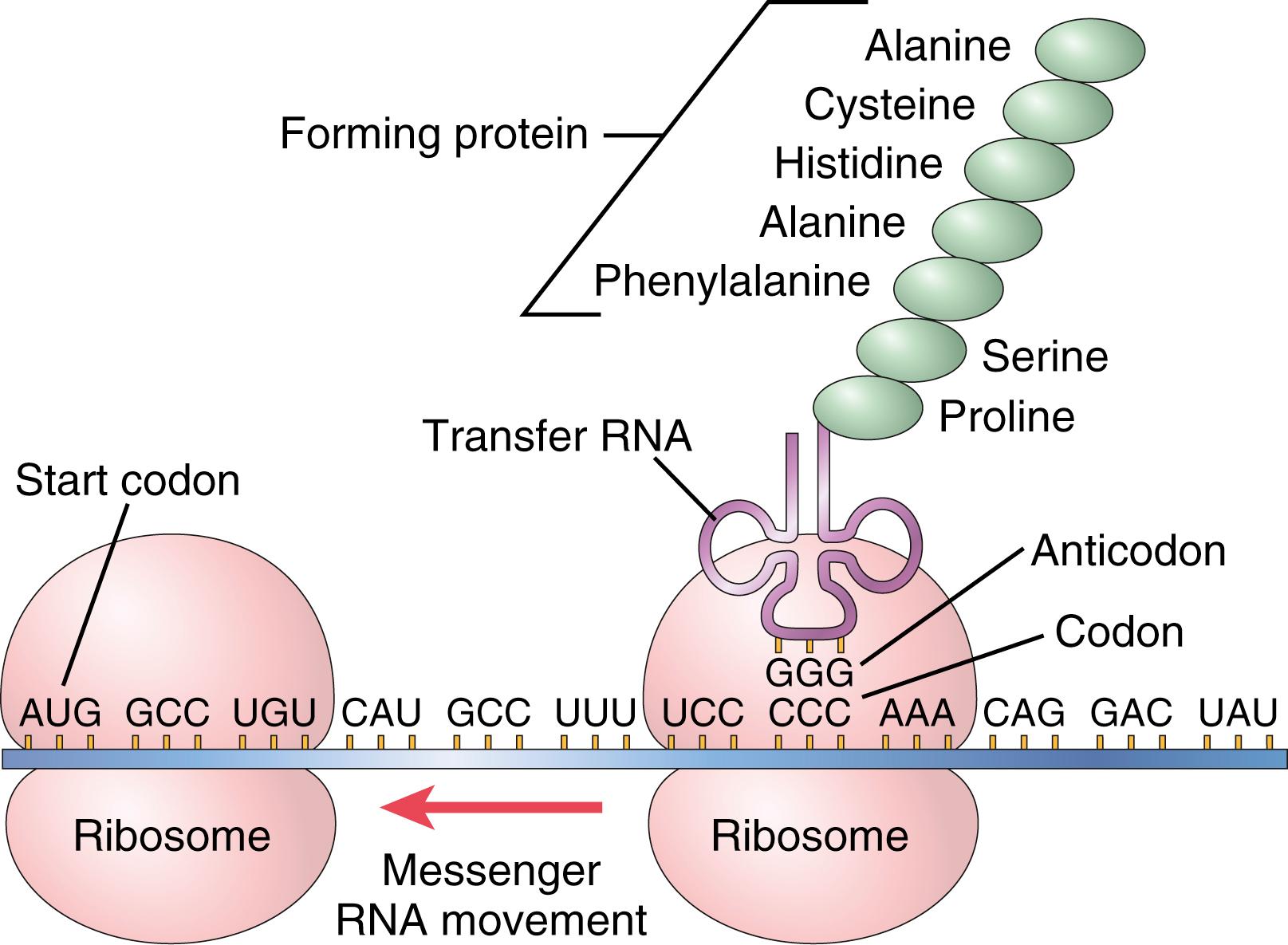
Because the function of tRNA is to cause attachment of a specific amino acid to a forming protein chain, it is essential that each type of tRNA also have specificity for a particular codon in the mRNA. The specific code in the tRNA that allows it to recognize a specific codon is again a triplet of nucleotide bases and is called an anticodon. This anticodon is located approximately in the middle of the tRNA molecule (at the bottom of the cloverleaf configuration shown in Figure 3-9 ). During formation of the protein molecule, the anticodon bases combine loosely by hydrogen bonding with the codon bases of the mRNA. In this way, the respective amino acids are lined up one after another along the mRNA chain, thus establishing the appropriate sequence of amino acids in the newly forming protein molecule.
The third type of RNA in the cell is ribosomal RNA, which constitutes about 60% of the ribosome. The remainder of the ribosome is protein, including about 75 types of proteins that are both structural proteins and enzymes needed to manufacture proteins.
The ribosome is the physical structure in the cytoplasm on which proteins are actually synthesized. However, it always functions in association with the other two types of RNA; tRNA transports amino acids to the ribosome for incorporation into the developing protein, whereas mRNA provides the information necessary for sequencing the amino acids in proper order for each specific type of protein to be manufactured. Thus, the ribosome acts as a manufacturing plant in which the protein molecules are formed.
The DNA genes for the formation of ribosomal RNA are located in five pairs of chromosomes in the nucleus. Each of these chromosomes contains many duplicates of these particular genes because of the large amounts of ribosomal RNA required for cellular function.
As the ribosomal RNA forms, it collects in the nucleolus, a specialized structure lying adjacent to the chromosomes. When large amounts of ribosomal RNA are being synthesized, as occurs in cells that manufacture large amounts of protein, the nucleolus is a large structure, whereas in cells that synthesize little protein, the nucleolus may not even be seen. Ribosomal RNA is specially processed in the nucleolus, where it binds with ribosomal proteins to form granular condensation products that are primordial subunits of ribosomes. These subunits are then released from the nucleolus and transported through the large pores of the nuclear envelope to almost all parts of the cytoplasm. After the subunits enter the cytoplasm, they are assembled to form mature functional ribosomes. Therefore, proteins are formed in the cytoplasm of the cell, but not in the cell nucleus, because the nucleus does not contain mature ribosomes.
Become a Clinical Tree membership for Full access and enjoy Unlimited articles
If you are a member. Log in here